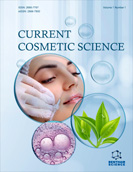
Full text loading...
We use cookies to track usage and preferences.I Understand
Background:Cannabis sativa seed oil has become more and more popular in cosmetic industry mainly due to the high content of antioxidants and unsaturated fatty acids that are desirable in formulations because they prevent moisture loss and reduce the occurrence of dry skin.
Objective: The aim of this study was to determine the effect of Cannabis sativa seed oil on skin parameters such as hydration and transepidermal water loss.
Methods: The in vivo tests on volunteers with combination skin were performed by using corneometer and tewameter.
Results: The obtained results proved that Cannabis sativa seed oil improved skin condition. The transepidermal water loss decreased because the lipophilic components of the oil formulation tend to form an occlusive layer on the epidermis surface. The highest increase in skin hydration was observed after one week of treatment.
Conclusion: These results confirmed that Cannabis sativa seed oil has strong moisturizing properties and can be recommended as a natural-based skin conditioning agent.

Article metrics loading...

Full text loading...
References


Data & Media loading...
Supplements

